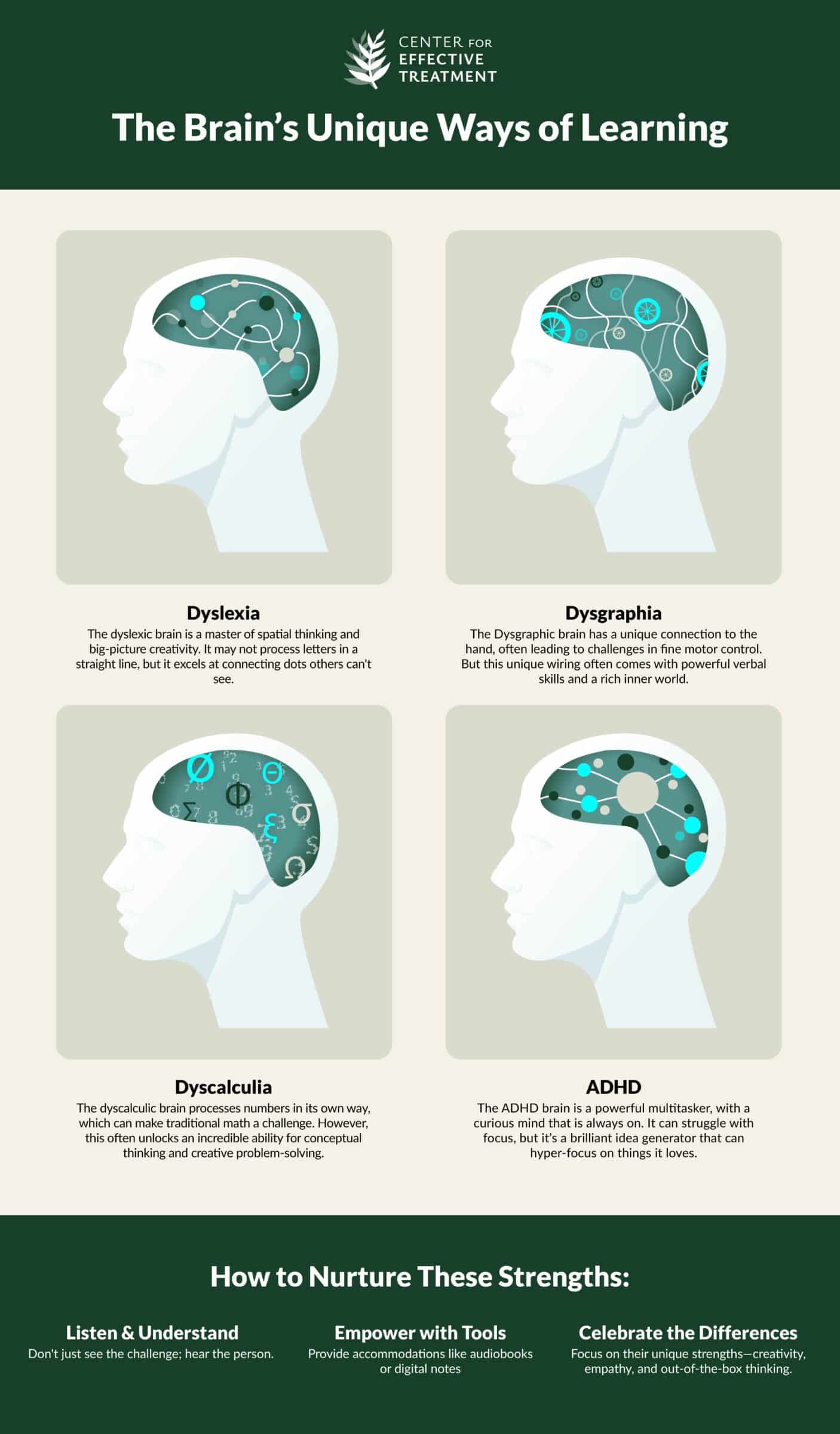Learning differences are lifelong. For some, they become obvious in early school years when a child struggles with reading, math, or writing. For others, they aren’t recognized until adulthood, when challenges with workplace tasks, organization, or time management persist. Either way, the impact of the different types of learning disorders can extend far beyond the classroom.
These conditions are not reflections of intelligence or motivation. They are differences in how the brain processes and expresses information. By recognizing them and accessing effective treatments, both children and adults can reduce frustration, build confidence, and find new ways to thrive.
Why is it so Important to Understand Different Types of Learning Disorders?
Misinterpretation is common. A child who avoids reading may be labeled as “lazy,” or an adult who misses deadlines at work may be judged as “careless.” In many cases, these struggles are tied to a learning disorder that changes how the brain handles specific tasks.
Recognizing the types of learning disorders matters for several reasons:
- For children, it can prevent years of academic struggles and allow early interventions that make school less stressful and more rewarding.
- For adults, it can provide long-awaited clarity, especially for those who spent school years feeling misunderstood. An accurate diagnosis can lead to workplace accommodations, career coaching, and a stronger sense of self.
The numbers make the case clear. According to the National Center for Education Statistics (2023), about 15% of students in U.S. public schools receive special education services, with learning disorders being the most common category. Meanwhile, studies suggest that many adults with learning disorders go undiagnosed, often adapting through workarounds without knowing the root cause of their struggles (APA, 2023).
By bringing awareness to these conditions, we create a path toward better outcomes-for children starting their education, and for adults who want to feel more capable in their personal and professional lives.
Common Types of Learning Disorders Explained

Learning disorders come in different forms, each affecting a specific set of skills. These conditions often appear in school, but they can also impact daily tasks and workplace responsibilities well into adulthood.
Dyslexia
Dyslexia is the most common specific learning condition, and while it typically affects reading and spelling, for some people it can impact writing and math. It’s not clear exactly how many people have it. Expert opinions vary widely, and estimates of the rate of dyslexia in kids range from 5 to 17.5 percent.
Children may struggle to decode words, read fluently, or remember sight words. Adults with dyslexia often read more slowly than peers, avoid reading-heavy tasks, or feel drained after long periods of reading. Despite these challenges, many individuals with dyslexia excel in creative problem-solving and big-picture thinking. Research suggests dyslexia affects between 5-10% of the population (International Dyslexia Association, 2024).
Dysgraphia
Dysgraphia is a condition and learning difference in which someone has difficulty with writing for their age level. In children, it may appear as messy handwriting, spelling errors, or difficulty organizing ideas on paper. For adults, dysgraphia can make it harder to write emails, prepare reports, or take legible notes. Speech-to-text technology and other supports can make these tasks more manageable.
Dyscalculia
Dyscalculia is a learning disorder that affects a person’s ability to do math. Children may struggle with basic number facts, sequencing, or solving word problems. Adults often find budgeting, managing finances, or interpreting data especially challenging. Current research suggests dyscalculia may affect 3-7% of children, and many of them carry these difficulties into adulthood (APA, 2023).
ADHD
Attention-Deficit/Hyperactivity Disorder is often diagnosed in childhood, but it affects adults as well. In school, ADHD may cause difficulty focusing, sitting still, or completing assignments. Adults may struggle with organization, time management, or maintaining focus in meetings. The CDC reported in 2023 that over 6 million children in the U.S. have an ADHD diagnosis (CDC, 2023), and many continue to experience symptoms into adulthood.
Nonverbal Learning Disorder (NVLD)
NVLD is characterized by challenges with visual-spatial skills, math reasoning, and interpreting nonverbal cues. Children may struggle with geometry or group work, while adults may find tasks like reading maps, managing spatial tasks, or interpreting body language difficult. NVLD often goes underdiagnosed, but support strategies can make a meaningful difference.
Related Conditions That Affect Learning
Some conditions are not learning disorders in the strictest sense but have a strong effect on learning.
- Processing Disorders: These affect how the brain interprets auditory or visual information. Children may have trouble following spoken directions, while adults may struggle in environments with a lot of background noise.
- Executive Functioning Challenges: These difficulties involve planning, organization, and self-monitoring. In school, they can affect turning in assignments on time; in adults, they may interfere with workplace projects or time management.
- Anxiety and Depression: Mental health conditions can make concentration and memory harder. For both children and adults, untreated anxiety may look like lack of focus or motivation.
- Autism Spectrum Disorder: Autism is not classified as a learning disorder, but differences in communication and processing can overlap with learning challenges.
Identifying these conditions alongside learning disorders ensures that treatment addresses the whole picture, not just one piece.
Exploring the Brain’s Unique Ways of Learning
Every brain processes information differently. Neuroscience shows that reading, writing, and math rely on specific regions of the brain, and disruptions in these areas can contribute to learning disorders.

Effective Treatment and Support Techniques for Different Types of Learning Disorders
Treatment for types of learning disorders varies on the age of the individual as well as their personal goals. Here are some of the approaches used for children and adults alike:
Structured Literacy for Dyslexia
Programs such as Orton-Gillingham use multisensory approaches to strengthen reading skills. For adults, literacy coaching and workplace accommodations like text-to-speech software can reduce frustration in reading-heavy jobs.
Writing Support for Dysgraphia
Occupational therapy helps children build handwriting skills. Adults may benefit more from assistive technology, including voice-to-text tools or software that organizes writing.
Math Interventions for Dyscalculia
Hands-on tools and visual aids benefit children, while adults may use calculators, budgeting apps, or specialized coaching to manage financial tasks.
ADHD Support
Behavioral therapy, structured routines, and medication are common treatments for children. Adults often combine therapy with productivity tools, coaching, and workplace accommodations to manage attention challenges.
NVLD Interventions
Social skills training can help children, while adults may benefit from direct coaching on interpreting nonverbal cues and handling spatial tasks.
Emotional Support for All Disorders
Counseling is often an overlooked piece of treatment. Both children and adults with learning disorders can develop anxiety or low self-esteem from years of feeling “different.” Therapy helps rebuild confidence and resilience.
How We’re Different
At The Center for Effective Treatment, we approach learning disorders with both clinical expertise and empathy. Our specialized therapy services integrate psychotherapy, evaluations, and treatment planning so that clients receive support for both academic and emotional needs.
- We believe no client is “too complex” or “untreatable.”
- We provide care that bridges psychotherapy and practical skill-building.
- We work with both children and adults, ensuring that support doesn’t end after school years.
This integrated model allows us to create lasting impact across school, work, and personal life.
Finding the Right Path: Next Steps and Support
For children, the next step may be scheduling a learning disability evaluation to identify what supports are needed for the school year. For adults, it may be seeking an evaluation to finally explain lifelong struggles with reading, writing, math, or organization. Either way, an accurate diagnosis opens the door to new strategies, accommodations, and personal growth.
It is never too late to seek help. Whether you’re a parent looking to support your child, or an adult recognizing patterns in your own life, the first step toward change is reaching out for evaluation and treatment.
At The Center for Effective Treatment, we are committed to walking alongside you in this process. By identifying the types of learning disorders and applying effective treatment strategies, we help children and adults alike find clarity, support, and confidence. Schedule a consultation with us today.

